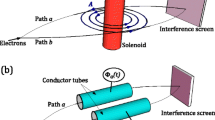Abstract
A Lagrangian description is presented which can be used in conjunction with particle interpretations of quantum mechanics. A special example of such an interpretation is the well-known Bohm model. The Lagrangian density introduced here also contains a potential for guiding the particle. The advantages of this description are that the field equations and the particle equations of motion can both be deduced from a single Lagrangian density expression and that conservation of energy and momentum are assured. After being developed in a general form, this Lagrangian formulation is then applied to the special case of the Bohm model as an example. It is thereby demonstrated that such a Lagrangian description is compatible with the predictions of quantum mechanics.
Similar content being viewed by others
Notes
I am indebted to a referee for pointing out that classical fields should be treated as distributions, rather than regular smooth functions of spacetime variables, and that products of such distributions as they occur here in
 in Eq. (1) can be mathematically ill-defined. Extension procedures of these ill-defined distributions are well-known in the mathematical literature (see, e.g., [5]) and if implemented beforehand lead to finite field theories. Since this issue already arises for standard expressions in physics such as Eqs. (1) and (7) in addition to the new equations introduced below, it will be assumed that the new framework is as mathematically consistent as classical mechanics and so the issue need not be pursued further here.
in Eq. (1) can be mathematically ill-defined. Extension procedures of these ill-defined distributions are well-known in the mathematical literature (see, e.g., [5]) and if implemented beforehand lead to finite field theories. Since this issue already arises for standard expressions in physics such as Eqs. (1) and (7) in addition to the new equations introduced below, it will be assumed that the new framework is as mathematically consistent as classical mechanics and so the issue need not be pursued further here.Note that \(\rho _0 \) is position dependent. This can be seen as follows: \(\rho _0 \) is a function of \(\mathrm{j}^\alpha \) via Eq. (9) and then \(\mathrm{j}^\alpha \) is a function of \(\psi \) via, e.g., Eq. (7). Therefore, since \(\psi \) is a function of position, \(\rho _0 \) is also a function of position.
Since, as mentioned in the introduction, the present discussion is limited to the free-space case,
 here does not contain any external potential. A term containing such a potential can easily be added, however. For example, the appropriate extra term for including an external 4-vector potential \(\mathrm{A}^\alpha \) would be of the form \(\mathrm{A}_\alpha \bar{\psi }\,\gamma ^\alpha \psi \).
here does not contain any external potential. A term containing such a potential can easily be added, however. For example, the appropriate extra term for including an external 4-vector potential \(\mathrm{A}^\alpha \) would be of the form \(\mathrm{A}_\alpha \bar{\psi }\,\gamma ^\alpha \psi \).The overall tensor \(\mathrm{T}^{\alpha \beta }\) defined here is actually the “canonical” energy-momentum tensor. In the case of spin-zero fields (e.g., the Klein-Gordon case) it is found to be symmetric under interchange of \(\alpha \) and \(\beta \), which implies conservation of angular momentum as well. In other cases, such as the Dirac field, \(\mathrm{T}^{\alpha \beta }\) is not symmetric. This is due to the fact that the canonical tensor only provides a description of orbital angular momentum density, not spin angular momentum density. Since these two contributions are not separately conserved, the canonical tensor is not an adequate description. Techniques exist to symmetrise this tensor and so include the spin part as well [8].
“Ensemble” in the present context refers to single particles considered in different runs of the same experiment.
Note that, although the particle velocity is constrained by Eq. (30) to be equal to the local current velocity, the converse is not necessarily true (in the sense that the current velocity is obviously not equal to the particle velocity at locations where the particle is absent).
References
Bohm, D.: A suggested interpretation of the quantum theory in terms of “hidden” variables. I and II. Phys. 85, 166–179 and 180–193 (1952)
Sutherland, R.I.: Phase space generalization of the de Broglie–Bohm model. Found. Phys. 27, 845–863 (1997)
Wharton, K.B.: The universe is not a computer. New Sci. 217, 30–31 (2012). arXiv:1211.7081
Wharton, K.B.: Lagrangian-only quantum theory. (2013). arXiv:1301.7012
Hormander, L.: The Analysis of Linear Partial Differential Operators I. Springer-Verlag, Berlin (1990)
Felsager, B.: Geometry, Particles and Fields. Springer-Verlag, New York (1998)
Goldstein, H., Poole, C.P., Safko, J.: Classical Mechanics, 3rd edn. Addison Wesley, Reading (2002)
Belinfante, F.J.: On the spin angular momentum of mesons. Physica 6, 887–898 (1939)
Hillery, M., O’Connell, R.F., Scully, M.O., Wigner, E.P.: Distribution functions in physics: fundamentals. Phys. Rep. 106, 121–167 (1984)
Gryb, S., Thebaault, K.: Symmetry and evolution in quantum gravity. Found. Phys. 44, 305–348. arxiv:1303.7139
Sutherland, R.I.: Causally symmetric Bohm model. Stud. History Philos. Mod. Phys. 39, 782–805 (2008). quant-ph/0601095
Acknowledgments
Thanks are due to Ken Wharton and to David Miller for kindly providing helpful feedback on this work.
Author information
Authors and Affiliations
Corresponding author
Rights and permissions
About this article
Cite this article
Sutherland, R.I. Lagrangian Description for Particle Interpretations of Quantum Mechanics: Single-Particle Case. Found Phys 45, 1454–1464 (2015). https://doi.org/10.1007/s10701-015-9918-1
Received:
Accepted:
Published:
Issue Date:
DOI: https://doi.org/10.1007/s10701-015-9918-1




 in Eq. (
in Eq. ( here does not contain any external potential. A term containing such a potential can easily be added, however. For example, the appropriate extra term for including an external 4-vector potential
here does not contain any external potential. A term containing such a potential can easily be added, however. For example, the appropriate extra term for including an external 4-vector potential